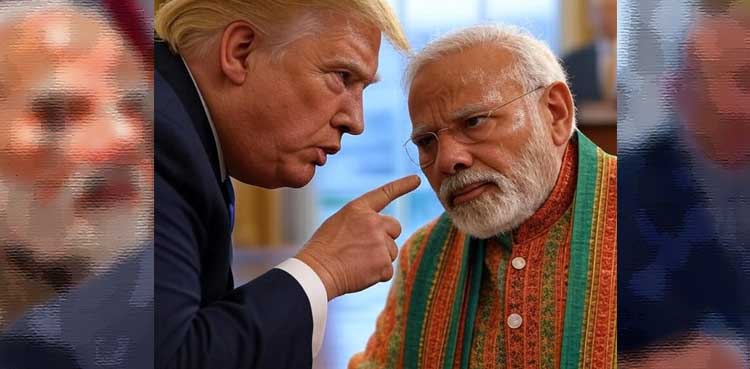On August 6, 2025, U.S. President Donald Trump signed an executive order doubling tariffs on Indian goods to 50%, effective August 27, 2025, in response to India’s continued imports of Russian oil.
This policy, adding a 25% tariff to an existing 25% tariff effective August 7, 2025, has sparked concerns in India under Prime Minister Narendra Modi’s leadership.
Let’s look at economic consequences of Trump’s tariffs on India, focusing on trade, growth, jobs, and Modi’s policy challenges.
Why Did Trump Impose Tariffs on India?
The U.S. tariffs target India’s purchase of Russian crude oil, which makes up about 35% of India’s oil imports, roughly 1.7 million barrels per day in 2024. The U.S. views these imports as undermining sanctions against Russia. India’s Ministry of External Affairs, under Modi’s government, called the tariffs “unfair, unjustified, and unreasonable,” stressing that India’s 1.4 billion people rely on affordable energy. Despite diplomatic efforts, the tariffs pose significant challenges for Modi’s economic agenda.
How Trump’s Tariffs Hurt India’s Exports
The U.S. is a major market for India, with $83 billion in exports annually (2024-25), including textiles, pharmaceuticals, electronics, and auto parts. Trump’s 50% tariffs will raise the cost of these goods, likely reducing U.S. demand. Industry experts predict a 10-15% drop in India’s U.S. exports, costing billions in revenue. Small and medium enterprises (SMEs), vital to Modi’s “Make in India” initiative, face the greatest risk, as they struggle to absorb higher costs or find new markets.
Impact on Modi’s Economic Growth Goals
Modi’s government has aimed for 6.8-7% GDP growth in 2025-26, according to the Reserve Bank of India. However, the Confederation of Indian Industry (CII) warns that Trump’s tariffs could cut growth by 0.5-1%. Lower export earnings, reduced industrial output, and weaker investment could slow India’s economy, challenging Modi’s vision of a $5 trillion economy. A weaker export sector may also strain India’s balance of payments, as exports help offset costly imports like oil.
Job Losses Under Modi’s Watch
Trump’s tariffs threaten millions of jobs in India’s export-driven industries. The textile and garment sector, employing over 45 million workers, is particularly vulnerable. A decline in U.S. exports could lead to layoffs or reduced hiring, especially in SMEs. Other sectors, like pharmaceuticals and electronics, face similar risks, putting pressure on Modi’s government to protect jobs and support workers.
Rising Costs and Inflation in India
The tariffs may drive inflation in India. Exporters facing higher costs might raise prices for goods like clothing and electronics, impacting consumers. If exporters absorb these costs, their profits could shrink, leading to reduced production or closures. A drop in export earnings could also weaken the Indian rupee, making imports like oil more expensive and adding to inflation under Modi’s administration.
Modi’s Energy Policy Challenge
Trump’s tariffs are tied to India’s reliance on Russian oil, which is cheaper than alternatives from countries like Saudi Arabia. Switching to costlier suppliers could raise energy prices, affecting industries and households. However, continuing Russian oil imports risks further U.S. sanctions, creating a dilemma for Modi. Balancing affordable energy with trade relations will be a key test for Modi’s government.
Modi’s Push for Trade Diversification
The tariffs highlight India’s need to reduce reliance on the U.S. market. Modi’s government may seek new trade partners in the EU, ASEAN, or the Middle East, but building these markets takes time. Accelerating free trade agreements, such as those with the UK or EU, could help. In the short term, Modi’s administration is exploring diplomatic talks to ease tariffs or filing a World Trade Organization (WTO) complaint, though this risks escalating tensions with the U.S.
Long-Term Outlook for Modi’s India
Trump’s tariffs pose immediate challenges but could push Modi’s government toward a more resilient economy. By diversifying trade, boosting domestic manufacturing, and investing in alternative energy, India can reduce vulnerabilities. However, these reforms require time and resources. For now, Modi faces the task of protecting businesses and workers while navigating U.S. trade pressures.
The Road Ahead
Trump’s 50% tariffs on India, effective August 27, 2025, threaten Modi’s economic goals by reducing exports, slowing growth, and risking jobs. Rising costs and inflation add further pressure, while India’s reliance on Russian oil complicates Modi’s policy options. By pursuing trade diversification and energy reforms, Modi’s government can mitigate the impact, but short-term challenges will test India’s economic resilience. The outcome will shape Modi’s legacy as he balances domestic growth with global trade dynamics.

Leave a Reply